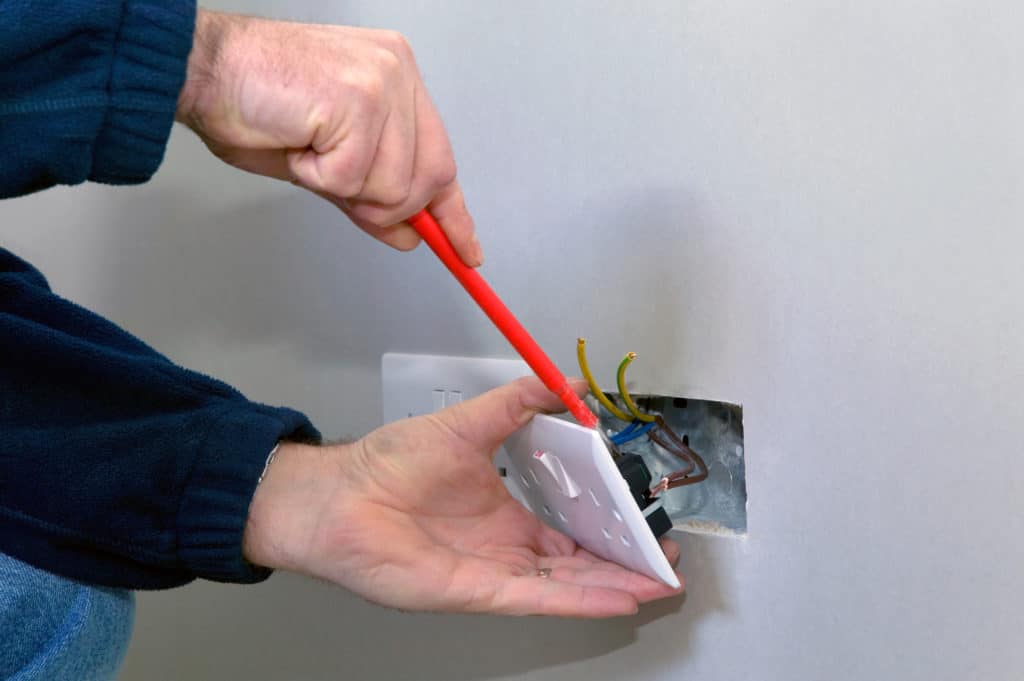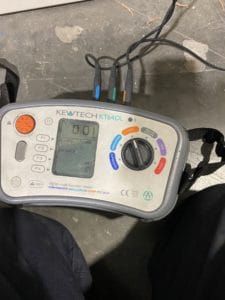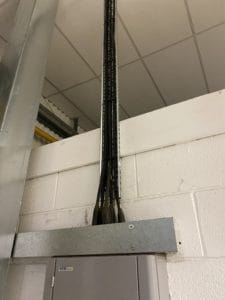Having just finished a particularly varied and interesting day I felt documenting today’s work would be a great way to demonstrate what electricians do on a daily basis. I’ve broken today down into 14 brief sections so readers can see the type of work you are going to have to do if you decide becoming an electrician is the career path for you.
Feel free to just skim the subheadings or read more if a section interests you. I hope readers will enjoy the brief snapshot of a day in my life as a commercial and domestic electrician!

What an electrician does on a daily basis (typical day as an electrician):
- Drive to the first job
- Meet the customer
- Carry out EICR
- Replace socket and light pendant
- Pack up tools and equipment
- Lunch
- Drive to the next job
- Meet colleagues on-site
- Install metal containment
- Install SWA cable
- Make final connections
- Carry out new installation tests
- Complete online test forms
- Pack up tools and drive home
Before I became an electrician I thought every day would consist of connecting up lots of cables. What you actually discover is that there is a huge variety of work that gets done. The process of connecting cables (or final fix as you’ll often hear it be called) is actually only a small part of the day.
1. Drive to the First Job
Sometimes as electricians we have to travel quite a lot for work, especially those that live in more rural areas. Fortunately for me, I live in a fairly big city (Bristol) so my travelling time is often not too long.
This morning I had the short drive to the south of the city so I hopped in the transit and made my way there with a cup of coffee in hand (safely of course)
2. Meet the Customer
Knocking on the door and meeting new customers becomes a daily part of the job. The vast majority of people are welcoming and happy to see you. Even when I’ve visited customers that are not so happy (perhaps they’ve struggled to get through to the office on the phone) their coldness often thaws out once they realise you are there to get the problem sorted.
The customer this morning was friendly and happy. She was the resident of the council house where my first job was to carry out a periodic inspection of the wiring in her home.
3. Carry out an Electrical Condition Report
Electrical inspection and condition reports (EICR as they’re known) are test reports that we carry out to assess the safety of the electrical circuits and equipment within a property.

There is an online test certificate I work my way through on the iPad (I use the NICEIC website but there are other organisations such as NAPIT that electricians use)
Using a multifunction tester I am able to test all the circuits for things such as RCD trip times and Zs readings. I also visually check to see if there are any issues that need addressing.
Once completed the landlord gets a certificate stating the condition of the electrical systems within the property are up to standard – or not to standard and improvements need to be made.
This part of being an electrician carries a lot of responsibility. As the electrician carrying out the test I am signing my name to say I have tested the property correctly. Using my knowledge and comparing the testing data with the regs book (BS7671) I’m sating whether the electrics within the property are safe for continued use or not.
The responsibility aspect of being an electrician is huge. We are personally liable to prosecution if anyone were to get hurt and it is found to be due to our negligence. The responsibility we have as electricians cannot be stressed enough.
4. Replace Socket and Light Pendant
Part of this contract with the customer to carry out the EICR is to put right any simple faults that need addressing at the time of the test
On this occasion, a socket was cracked and a light switch was operating poorly so these needed replacing. These are fairly straightforward tasks, and as I carry some spares on the van, I was able to get them changed quickly (How long it takes to replace a light)
5. Pack Up Tools and Equipment and Say Bye to Customer
I always take the time to give the customer a little run down of what’s been done and answer any questions they may have.
Then it’s a quick check to make sure no tools have been left behind (easily done) and then pack the van up and head off to find a nice sandwich for lunch.
6. Lunch
The timings of lunch vary from day to day as it depends where we are in the progress of a job – we don’t drop everything to go and have lunch at a set time each day. In-between jobs like today provide a great opportunity to pop to the shop and grab some nice food and a coffee.
All electricians are accustomed to eating in their vans and the van becomes a little mobile office and a home from home for us.
7. Drive to the Next Job
My next site for the day was at a company that manufacturers aeroplane parts, which was on the other side of the city, so its sat-nav turned on to help find the best way through the traffic and off I went.
8. Meet my Colleagues On-Site
I’ve been to this job before so I didn’t need to go through the whole induction process again. Instead, I was able to read the method statement, fill out a quick on-site risk assessment and meet the other guys already hard at work.
It’s worth stopping to look at the point about risk assessments and method statements. Health and safety is a huge part of daily life as an electrician and we get very well versed at complying with the large amounts of health and safety procedures now in place. It’s not just the PPE that we wear there is a lot of paperwork and procedures in place to keep electricians away from danger.
9. Install Containment for Cables

On this job, we were installing metal tray as the containment system for our cables to be placed on. Containment systems are a huge part of being an electrician. If we want to get the cables from location A (usually a local distribution board) to location B (in this case a 110v socket with a built-in transformer mounted on the wall) we must put containment in for the cables to be placed on.
The regulations state that all cables must be adequately supported throughout their length. Apart from this being good working practice (and all part of doing a good job), the regs dictate that we must do it in order to comply.
Containment takes up a large amount of our time daily, especially for commercial electricians. There are lots of different containment types you will learn how to install during an apprenticeship.
10. Install SWA cable onto Tray
SWA refers to steel wired armour cable and is a common cable used in commercial electrical work, as can be seen in the photo above.
We pulled the cable from the drum that it is delivered on, up onto the tray we just installed and ran the cable over to the new sockets we want to connect up. We then attached this cable securely to the tray using both plastic and metal cable ties (the metal ties help prevent the cable from falling down in the event of a fire, which is another reg)
We then had a length of cable about 30 metres long, running between the local distribution board, (commercial consumer unit) and the endpoint where the new socket is mounted.
Pulling cables in can be tricky so it is always nice on days like today to have a few colleagues around to give a hand.
11. Make the Final Connections
As there were two of us, I chose to make the SWA cable off into the new socket whilst, my friend (more of a colleague really!) made the other end off into the distribution board (which was locked off and proved dead so we knew there was no danger of an electric shock)
Making off is the term given to terminating the cables and carrying out the final connections. This is the bit we often think of electricians doing, actually stripping wires and tightening them into terminals with screwdrivers.
12. Carry Out Electrical Tests and Make the Circuit Live
Once the connections have been made and my colleague and I are both happy, it’s then time to carry out all the necessary electrical safety tests.
Using the same multifunction tester (not a cheap piece of kit, I’ll link to one on amazon here so you can see the price ranges for yourself) as I used this morning, but this time we need to complete a new installation certificate to certify that the new installation work we have done is safe and meets required standards.
As readers can see, testing plays a huge role in an electrician’s daily routine as once again I am signing to certify that the work carried out does not present harm to life or property.
13. Complete Online Test Certificate
Using the online NICEIC system I mentioned earlier I have to fill out a new installation test form to certify the work. Currently, the test form for a new installation is 6 pages long and requires lots of information to be gathered from the customer.
On big sites such as this one getting all the information needed can be tricky and requires lots of keys to be found and cupboard doors to be open.
14. Pack Up Tools and Tidy Up
Once the job was finished it was time to pack up tools, checking again that non have been left behind (losing tools seems to be a hobby of mine). Then it’s a tidy up around site throwing any rubbish etc in the van and then it’s homeward bound for the day!
I hope readers have found a day in the life of an electrician useful information to help understand the type of things you will be doing if you become an electrician.
In my opinion, the best thing about being an electrician is that there is so much variety each day. (Believe it or not, we can even find ourselves getting drug and alcohol tested at work)
To sum up, an average day as an electrician never gets boring as we’re always out and about and each day is different.
